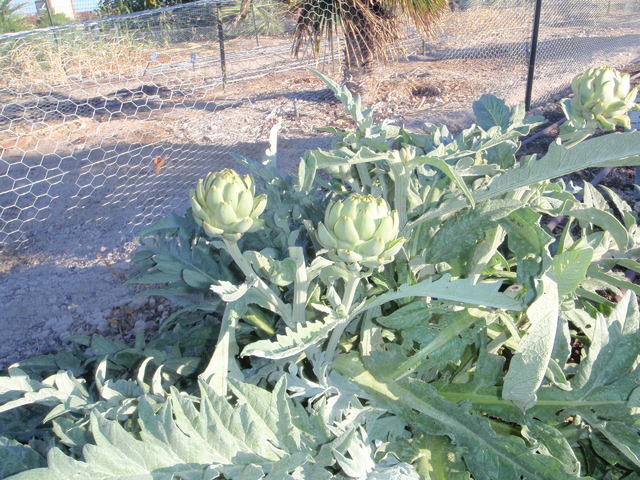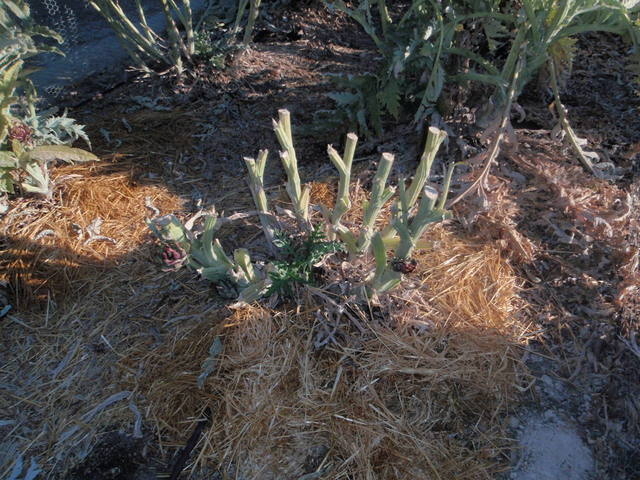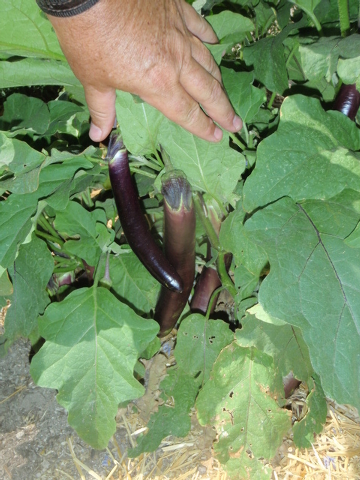Get rid of armyworms the natural way
Q: What is the worm or caterpillar that attacks artichoke plants and how do I control them? I had a beautiful artichoke plant last year and had four or five great artichokes from it right away. Then the worms (caterpillars) struck and were all through the artichokes. I cut it down and it came back beautifully but now the worms or caterpillars are eating all of the leaves.
A: This is most likely either damage from armyworms or loopers. I am guessing that it is probably armyworm.
It doesn’t matter which one, the control measures are the same, just the timing could be different. The usual time we see damage from armyworms is either in the spring or the fall. They can attack the leaves or the flower buds.
Loopers crawl along like the cartoons of caterpillars where the midsection “loops” up in a curve. Armyworms don’t.
You would use either a spray of Dipel, Thuricide or Spinosad. All three of these sprays are considered organic and do a very good job on these types of critters. Their death is not immediate but they do stop feeding a very short time after these sprays come in contact with them. They will die a couple of days later.
If you see them now, spray. Mark your calendar for next year and spray when you first start to see damage. You can apply a preventive using your calendar as a guide to when to apply.
These sprays are good to have around since they can be used to control a number of different “wormy” pests on tomatoes, peppers, eggplant, grapevines, fruit trees, petunias and many other plants.
Q: We have an azalea planted on the northeast side of the house. At this time of year it gets no sun. The tips of its leaves are brown. What needs to be done?
A: Azalea is a very difficult plant to grow in our climate and soils. It likes soils on the acidic side, with lots of organic matter in the soil, absolutely hates salts and salinity, and does not handle direct sunlight very well at all in the desert.
That being said, I also planted one about 30 years ago in a very similar exposure. It did the same thing as yours and that is the leaf tips turned brown or died after about three years.
If you are going to try and make this work to any degree at all, your exposure would be OK but you have to modify your soil with lots of good compost, finely ground sulfur or aluminum sulfate to help lower the pH of the soil, and wood mulch.
Make sure you have enough water surrounding the plant so that the soil doesn’t dry out. If this was my plant, I would push any salts out of the soil surrounding the roots by letting the hose slowly run water around the base of the plant for several hours so it is completely drenched. I would wait two or three days and do it again.
The purpose of this is to push out any salts that may have accumulated around the roots. I would check to make sure that there are enough drip emitters, if that’s what you’re using, to thoroughly wet the soil around the plant every time it irrigates. If not, I would add some.
Next, I would lightly dig in around the base of the plant some good compost mixed with finely granulated sulfur and some iron chelate.
Then, I would look for a specialty fertilizer for azaleas and fertilize the plant lightly this fall. If this were a water-soluble fertilizer I would mix it in a bucket of water and pour around the base of the plant. I would repeat the fertilizer application in the spring.
Finally, I would cover the soil under the plant with a couple of inches of wood chip mulch. The old leaves that have scorched tips will remain on the plant until you get some new growth and they finally drop off.
Q: I have grown plants in whiskey barrels every year with a good harvest. This year my eggplants have grown bigger than ever, beautiful, look healthy and have lots of purple flowers but almost no fruit. Since planting it’s just been one giant flower bush. Why is it not producing fruit?
A: I am guessing it is a combination of probably three things: variety, weather conditions and general care.
Stick to varieties of eggplant that have done well for you in the past. Don’t just buy any eggplant off the shelf and expect the same results. Varieties are important.
Second is the weather. At very high temperatures many vegetables will fail to set fruit. This is because the pollen may become sterile at high temperatures and the fruit will start to develop and fall off. Some varieties are better at setting fruit at high temperatures than others.
Third is soil enrichment and fertilizing. If your soil has been amended with a good quality compost prior to planting then I would not fertilize with any nitrogen fertilizer until I saw fruit develop that was a couple of inches long.
If the soil is enriched heavily with good compost and then we fertilize the plants with high nitrogen fertilizers, we can end up with wonderful vegetable bushes with little to no fruit.
I would suggest you mulch the plants as well. This will help keep soil moisture more constant. If soil moisture goes up and down during the day, the plant may drop flowers or fruit as well.
Less likely is a lack of bee activity. I am guessing your bee activity has been about the same as previous years so that it is not likely to be the problem.
Q: I have a Chinese pistache tree which is nice and green but the leaves began to curl. I spoke to someone at the nursery where I bought it; I did what they said but I am not seeing any change yet. Can you help me save my tree that cost me so very much money when I had planted it last year?
A: Chinese pistache is a tree that does very nicely in our desert climate with very few problems. One thing that it hates is a soil that stays wet.
Curling leaves on pistachio can be an indicator of a water or insect problem. Once the leaves are curled, however, these leaves will not straighten out again. However new leaves that come out should be normal if you have corrected the problem.
Curled leaves can indicate water stress: not enough water in the soil or water applied too often. If watered too often, curled leaves can be an indicator of root rot or trunk rot at the soil level, which is called collar rot. Collar rot results if the soil is kept constantly wet or it is buried too deep.
Whatever you do, be sure not to water this tree daily. You will kill it if you do. You are far better off giving it more water than it needs, but applying less often.
The amount of water to apply depends on its size. How often you apply the water depends on the time of year.
In midsummer you should not be watering more often than three times a week. For desert-adapted trees like this one you should be able to get by on one or, at the most, two waterings in one week.
I wish I could tell you how many minutes of water to apply, but water does not work in minutes; it works in gallons. If your tree is watered by drip irrigation, you should have four drip emitters around the tree.
Once the tree is above 10 feet, you should be adding more emitters around the tree. The emitters should be no closer than about 18 inches from the trunk.
If the problem is from insects feeding on the leaves and causing them to curl, a systemic insecticide intended to be applied to the soil above the roots should kill the insects. The leaves that are curled will stay curled. You will not see normal leaves until you see new growth.
Bob Morris is a horticulture expert living in Las Vegas and professor emeritus for the University of Nevada. Visit his blog at xtremehorticulture.blogspot.com. Send questions to Extremehort@aol.com.



















